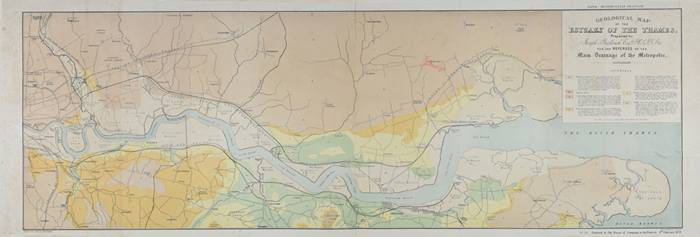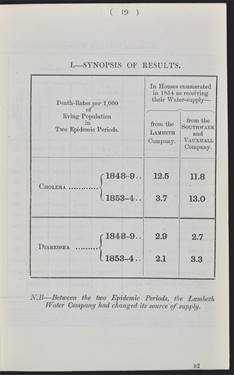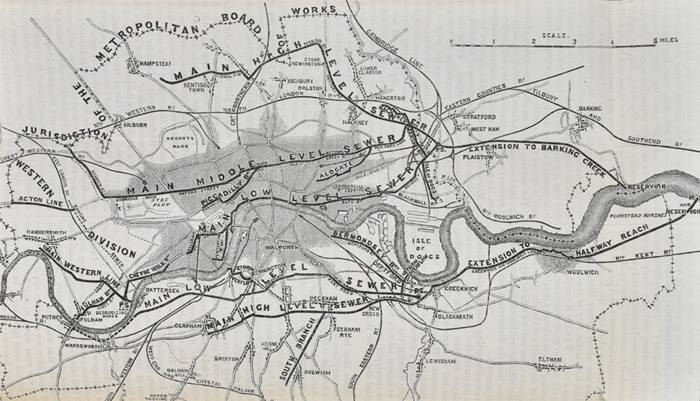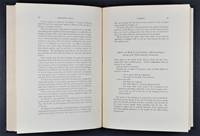1852 Metropolis Water Act

|
Joseph Prestwich’s ‘Geological Map of the Estuary of the Thames’ which was prepared for the Referees of the Main Drainage of the Metropolis in 1858. GSL Library collections. The black lines indicate the suggested location for the route of the outfall channel sewers for the north and south sides of the Thames which will skirt along the Chalk. Click to enlarge
|
Despite the efforts of Robert Stephenson, Joseph Prestwich and many others who interested themselves in finding alternative solutions to the water supply problem in London, the 1852 Metropolis Water Act effectively allowed the water companies to continue to use the Thames as their main water source. They were, however compelled to move their intake higher up the river and (in theory) away from the sewage outlets. The water was also to be covered at all times and filtered before it could reach the customer. Unfortunately the water companies were given until the end of 1855 to enact the changes, but for many Londoners it was too late to prevent the Cholera outbreak of 1853/4. Mismanagement of these processes also led to the outbreak of 1866.

|
In this simple chart, John Simon, Medical Officer to the Board of Health, compares the deaths from Asiatic Cholera and diarrhoea between the two water companies whose supply John Snow blamed for the 1848/9 Cholera outbreak.
The Lambeth Company had complied with the new legislation quickly and changed its supply in 1852. The Southwark & Vauxhall Company had not. In his report, Simon notes: “And such were the sources of supply of the two companies referred to; the Lambeth Company pumping from the higher part of the river, the Southwark and Vauxhall Company the lower; the former furnishing as good as water as any distributed in London, while the latter was purveying perhaps the filthiest stuff ever drunk by a civilised community.” (p5)
From: John Simon, 'Report on the last two Cholera-Epidemics of London as affected by the consumption of Impure Water,' London: George E Eyre and William Spottiswoode (1856). Tracts: Prestwich P/3
|
The Great Stink

|
Map of the proposed lines of the main drainage and intercepting sewers to be constructed under the supervision of Joseph Bazalgette, [1858] probably taken from the 'Engineer Magazine'. Tracts: Prestwich P/2.
|
The 1852 Act did nothing to prevent the source of the problem which was sewage. Tons of untreated human waste were still flowing into the Thames on a daily basis. This was to change in 1858 when the hot summer exacerbated the smell from the Thames so much that the period gained the name The Great Stink. The windows in Parliament overlooking the Thames were closed and despite the curtains being soaked in chloride of lime the stench was overpowering. It took just 18 days for the legislation to be passed and the funding to be found to begin construction on Joseph Bazalgette’s mammoth sewage infrastructure. Taking around 20 years to construct, the intricate sewer system diverted waste from the Thames by pumping it, through outfall channels, eight miles downstream. However the sewage was still untreated and was directly responsible for the deaths of the majority of the 600 passengers of the pleasure steamboat Princess Alice which sank in 1878. 75 million tons of waste had been pumped into that part of the Thames an hour earlier. This tragedy would lead to the development of sewage treatment plants in London.

|
Joseph Lucas, 'Horizontal wells: a new application of geological principles to effect the solution of the problem of supplying London with pure water’ (1874). GSL Library collection. The phrase 'hydro-geological survey' is used on the right hand page. Click to enlarge. |
Despite these developments, geologists still concerned themselves with London’s water supply. Prestwich’s theoretical work would be confirmed and expanded upon by figures such as William Whitaker, FGS, and Joseph Lucas, FGS (1846-1926). Although Whitaker is sometimes referred to as the ‘father of English hydrogeology’ it was Lucas in whose book ‘Horizontal wells: a new application of geological principles to effect the solution of the problem of supplying London with pure water’ (1874) the modern meaning of the term ‘hydro-geological survey’ was first coined.
Groundwater from aquifers now provides 30-40% of the water supply to London and the Thames Valley. In some regions in Britain it rises to 80%.
<<Back to main page